Interesting Tech' Article on Oil System Upgrades
Posted on
HVX MODS
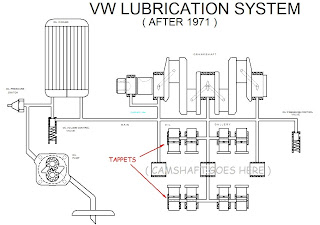
The air-cooled Volkswagen engine doesn’t have a very good lubrication system. (Which isn’t surprising, seeing as the design dates back to Xavier Reimspiess’ original 1931 ‘boxer’ engine.) Its inadequacies became evident in the late 1950's when me and a few other fools started hot-rodding the things.
The Ford Motor Company had recently published a study of the effects of oil filtration systems on engine wear and the results were so impressive that by the time you could say ‘Jack Robinson’ we’d retro-fitted our bugs with oil filters. But the main problem wasn't dirty oil but not enough oil, especially at high rpm. The inadequate amount of lubrication reaching the heads resulted in excessive friction, leading to high temps and failed valve-train components, which put you out of the race.
Auditing the engine’s lubrication system we found that all of the oil for both heads came through a single 5mm drilling. In theory, a hole that size should have provided more than enough oil. And it did, but only for the left-hand head. And then, only at low rpm. Which was fine for a stock 1200cc 36hp engine, but we’d already bored & stroked that puppy to nearly 1700cc and were running them at over 5000 rpm. But not for very long.
Volkswagen was aware of the valve-train lubrication problems and added a drilled oil channel to the rocker arms and a larger main oil gallery on later engines but the basic problem was that not enough oil was reaching the heads, especially the one on the right-hand side of the engine.
(NOTE: VW orientation is always relative to the driver. The right-hand head is the 1 & 2 cylinder bank, left-hand is the 4 & 3 bank.)
To get oil to the right-hand head, VW cuts a square groove in the bearing saddle for the #2 cam bearing. All of the oil to the right-hand side of the engine gets there through that channel. (And still does, if you haven’t modified the crankcase.)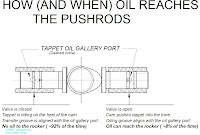
To make matters worse, the oil to the heads gets there via the cam-followers... but only when that particular valve is actuated. In effect, the VW cam-followers act as a valve, shutting off the oil to the heads for approximately 92% of the time.
To get an engine that could run flat-out for 24 hours we had to get more oil to the heads. To do that we tried opening up the oil channel in the cam-bearing web. That worked but we still weren’t getting eno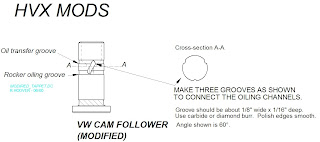 ugh juice. So we modified the cam-followers to allow oil to reach the heads 100% of the time instead of only when the valve was actuated. Major improvement, but we were still seeing galling on the right-hand rocker-arm shaft, plus an occasional hair-pin fracture. What we needed was still more oil... especially to the right-hand side of the engine.
ugh juice. So we modified the cam-followers to allow oil to reach the heads 100% of the time instead of only when the valve was actuated. Major improvement, but we were still seeing galling on the right-hand rocker-arm shaft, plus an occasional hair-pin fracture. What we needed was still more oil... especially to the right-hand side of the engine.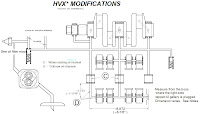
To do that, on the right-hand case half we extended the oil gallery for the cam-followers to intersect with a new oil channel we drilled into the #3 cam bearing web. Big, BIG change. And lower head-temps, too.
With that as a clue, we grooved the rocker-arm shafts to match the oil channels drilled into the rockers. Fitted with the Ford/Subie type swivel-foot adjusters, which have a matching oil channel, we could now provide the heads with approximately eight times as much oil as before. Heads ran much cooler... which meant the oil coming from the heads was hotter, so we had to come up with a better oil-cooling scheme. Which we did, moving the oil cooler outside of the blower housing.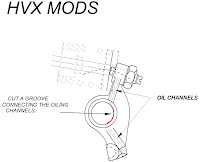
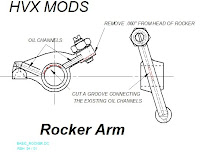
All of which is pretty old news to anyone hanging out at the finish line. Bu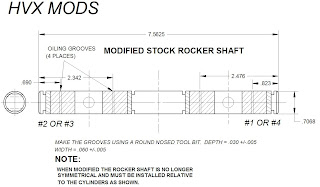 t a total blank to just about everyone else. The magazines were only interested in the mods when there was something to sell, such as an oil filter bracket or an oil cooler core. All of the fiddley bits that made the system work, such as drilling the new oil channels or grooving the rocker shafts, were seen as just more of those ‘unimportant’ details professional engine-builders are always messing with. (Most magazine 'technical' articles are nothing more than infomercials, intended to sell whatever product is being touted. )
t a total blank to just about everyone else. The magazines were only interested in the mods when there was something to sell, such as an oil filter bracket or an oil cooler core. All of the fiddley bits that made the system work, such as drilling the new oil channels or grooving the rocker shafts, were seen as just more of those ‘unimportant’ details professional engine-builders are always messing with. (Most magazine 'technical' articles are nothing more than infomercials, intended to sell whatever product is being touted. )
A key point here is that a high-output engine needs all of the modifications described above: 100% filtered oil, increased oil volume to the right-hand side of the crankcase, 100% oil flow through the lifters, grooved rockers & rocker-arm shafts, and the Ford/Subie-type swivel-foot adjusters, which act as spray-bars. Some guys would modify the rockers and say they didn’t see any improvement. Others would modify the lifters and say the same. But not one in a thousand incorporated all of the modifications. And still don’t. But it’s interesting to note that Volkswagen included all of the modifications to the Type IV engine. In fact, you can find them in every modern-day engine. Which is just another of those ‘unimportant’ details.
-R.S.Hoover
Original source - http://bobhooversblog.blogspot.co.uk/2007/05/hvx-mods.html

Add a comment: